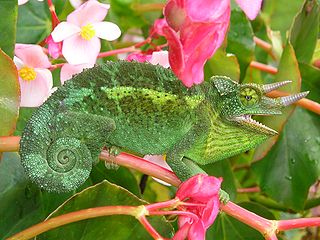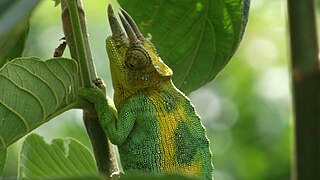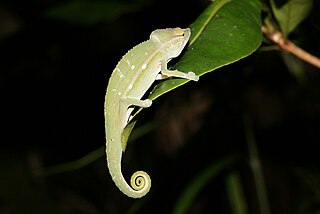
Chameleons or chamaeleons are a distinctive and highly specialized clade of Old World lizards with 200 species described as of June 2015. The members of this family are best known for their distinct range of colors, being capable of color-shifting camouflage. The large number of species in the family exhibit considerable variability in their capacity to change color. For some, it is more of a shift of brightness ; for others, a plethora of color-combinations can be seen.

Bradypodion is a genus of chameleons in the family Chamaeleonidae, collectively called South African dwarf chameleons. All species are found in South Africa and most are endemic to this country, but a few can also be found in Eswatini, Lesotho, southernmost Namibia and possibly southernmost Mozambique. They are quite small chameleons where the different species often can be difficult to separate by appearance, although exact location and the intense breeding colours of males are useful for their identification. They are arboreal, but some species are mostly found low in the vegetation.

Chamaeleo is a genus of chameleons in the family Chamaeleonidae. Most species of the genus Chamaeleo are found in sub-Saharan Africa, but a few species are also present in northern Africa, southern Europe, and southern Asia east to India and Sri Lanka.

Jackson's chameleon, also known as Jackson's horned chameleon, three-horned chameleon or Kikuyu three-horned chameleon, is a species of chameleon native to East Africa, and introduced to Hawaii, Florida, and California.

The Malagasy giant chameleon or Oustalet's chameleon is a large species of chameleon which is native to entire Madagascar, but also has been introduced near Nairobi in Kenya and in Miami-Dade County in the United States. It occurs in a wide range of habitats, even among degraded vegetation within villages, but is relatively rare in the interior of primary forest.

Trioceros johnstoni, known commonly as Johnston's chameleon, Johnston's three-horned chameleon, or the Ruwenzori three-horned chameleon, is a species of chameleon, a lizard in the family Chamaeleonidae. It is endemic to highlands in the Albertine Rift in central Africa. It reaches up to 30 cm (12 in) in total length and only the adult male has three horns; females are hornless.

Trioceros is a genus of lizards in the family Chamaeleonidae, the chameleons, native to lowlands and highlands in the African mainland, ranging from Ethiopia south to Mozambique and west as far as Ghana. Trioceros was considered a subgenus of the genus Chamaeleo until 2009, when it was elevated to full genus level.

The flap-necked chameleon is a species of arboreal chameleon, a lizard in the family Chamaeleonidae. The species is native to sub-Saharan Africa. There are eight recognized subspecies, including the nominotypical subspecies.
Kinyongia carpenteri, commonly called Carpenter's chameleon or the helmeted chameleon, is a species of chameleon, a lizard in the family Chamaeleonidae. The species is native to central Africa.

Chamaeleoninae is the nominotypical subfamily of chameleons. The Family Chamaeleonidae was divided into two subfamilies, Brookesiinae and Chamaeleoninae, by Klaver and Böhme in 1986. Since its erection in 1986, however, the validity of this subfamily designation has been the subject of much debate, although most phylogenetic studies support the notion that the pygmy chameleons of the subfamily Brookesiinae are not a monophyletic group. While some authorities have previously preferred to use the subfamilial classification on the basis of the absence of evidence principal, these authorities later abandoned this subfamilial division, no longer recognizing any subfamilies with the family Chamaeleonidae. In 2015, however, Glaw reworked the subfamilial division by placing only the genera Brookesia and Palleon within the Brookesiinae subfamily, with all other genera being placed in Chamaeleoninae.

Trioceros hoehnelii, commonly known as von Höhnel's chameleon, the helmeted chameleon, and the high-casqued chameleon, is a species of chameleon, a lizard in the family Chamaeleonidae. The species is endemic to eastern Africa.

The crested chameleon, also known as the sail backed chameleon, is a species of chameleon native to forests and semi-open wooded habitats in Central Africa.

Owen's chameleon, also commonly known as Owen's three-horned chameleon, is a species of lizard in the family Chamaeleonidae. The species is native to forests in central Africa. Named after British naval officer and explorer William Fitzwilliam Owen, it was first described in 1831 by the naturalist John Edward Gray, and is the type species of the genus Trioceros.
Trioceros chapini, also known commonly as Chapin's chameleon, the gray chameleon, and the grey chameleon, is a species of lizard in the family Chamaeleonidae. The species is native to Central Africa.

Trioceros ellioti, also known commonly as Elliot's chameleon, Elliot's groove-throated chameleon, and the montane side-striped chameleon, is a species of lizard in the family Chamaeleonidae. The species is indigenous to Africa.
Trioceros feae, also known commonly as the Bioko montane chameleon and Fea's chameleon, is a species of lizard in the family Chamaeleonidae. The species is endemic to the island of Bioko.
Trioceros fuelleborni, also known commonly as the flapjack chameleon, the Ngosi Volcano chameleon, and the Poroto three-horned chameleon, is a species of lizard in the family Chamaeleonidae. The species is endemic to Tanzania.
Trioceros goetzei, also known commonly as Goetze's chameleon, Goetze's whistling chameleon, and the Ilolo chameleon, is a species of lizard in the family Chamaeleonidae. The species is native to eastern Africa. There are two recognized subspecies.
Trioceros harennae, also known commonly as the Harenna hornless chameleon, is a species of lizard in the family Chamaeleonidae. The species is endemic to Ethiopia. There are two recognized subspecies.

Chamaeleo intermedius is an extinct species of chameleon from the Miocene of Kenya. It was given its name based on the fact that it shares traits with both species of the genus Chamaeleo and those of Trioceros, which at the time were placed in the same genus. This belief that it was an intermediate form was however rejected by later research.
















